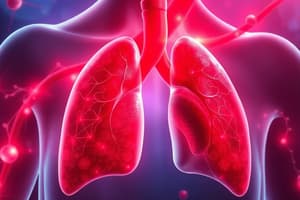Podcast
Questions and Answers
Which element is NOT part of Virchow's Triad related to the causes of Deep Vein Thrombosis (DVT)?
Which element is NOT part of Virchow's Triad related to the causes of Deep Vein Thrombosis (DVT)?
- Vessel wall injury.
- Altered blood coagulation.
- Stasis of blood (venous stasis).
- Arterial plaque buildup. (correct)
A patient on bedrest is at risk for venous stasis. How does bedrest affect blood flow in the legs?
A patient on bedrest is at risk for venous stasis. How does bedrest affect blood flow in the legs?
- Doubles the blood flow.
- Has no effect on blood flow.
- Increases blood flow by 25%.
- Reduces blood flow by 50%. (correct)
Which assessment finding is LEAST likely to be associated with a Deep Vein Thrombosis (DVT) in the lower extremity?
Which assessment finding is LEAST likely to be associated with a Deep Vein Thrombosis (DVT) in the lower extremity?
- Prominent superficial veins in the affected limb.
- Edema and swelling of the affected limb.
- Decreased temperature in the affected limb. (correct)
- Tenderness upon palpation of the affected area.
A patient is diagnosed with superficial thrombosis. What signs and symptoms would the nurse expect to find upon assessment?
A patient is diagnosed with superficial thrombosis. What signs and symptoms would the nurse expect to find upon assessment?
A patient is prescribed heparin for DVT. What lab value requires monitoring to ensure the medication is within therapeutic range?
A patient is prescribed heparin for DVT. What lab value requires monitoring to ensure the medication is within therapeutic range?
Why is it necessary to continue heparin therapy when a patient with DVT is started on warfarin (Coumadin)?
Why is it necessary to continue heparin therapy when a patient with DVT is started on warfarin (Coumadin)?
What is a major advantage of using thrombolytic therapy for DVT compared to anticoagulant therapy alone?
What is a major advantage of using thrombolytic therapy for DVT compared to anticoagulant therapy alone?
A patient with DVT is prescribed bedrest. What nursing intervention can be implemented to prevent embolization while on bedrest?
A patient with DVT is prescribed bedrest. What nursing intervention can be implemented to prevent embolization while on bedrest?
What is the most common origin of a thrombus that causes a pulmonary embolism (PE)?
What is the most common origin of a thrombus that causes a pulmonary embolism (PE)?
Which symptom is LEAST likely to be associated with a pulmonary embolism (PE)?
Which symptom is LEAST likely to be associated with a pulmonary embolism (PE)?
A patient is suspected of having a pulmonary embolism (PE). Which diagnostic test is most accurate in visualizing a PE?
A patient is suspected of having a pulmonary embolism (PE). Which diagnostic test is most accurate in visualizing a PE?
Which finding on an Arterial Blood Gas (ABG) is most likely to indicate a pulmonary embolism (PE)?
Which finding on an Arterial Blood Gas (ABG) is most likely to indicate a pulmonary embolism (PE)?
Which intervention is LEAST likely to be used in the prevention of pulmonary embolism (PE)?
Which intervention is LEAST likely to be used in the prevention of pulmonary embolism (PE)?
A patient with PE is hypotensive and hypoxemic despite oxygen administration. Which medication is most appropriate to administer?
A patient with PE is hypotensive and hypoxemic despite oxygen administration. Which medication is most appropriate to administer?
A patient is receiving thrombolytic therapy for a pulmonary embolism (PE). What is the MOST critical nursing action during this treatment?
A patient is receiving thrombolytic therapy for a pulmonary embolism (PE). What is the MOST critical nursing action during this treatment?
Which condition is an absolute contraindication for thrombolytic therapy in a patient with a pulmonary embolism (PE)?
Which condition is an absolute contraindication for thrombolytic therapy in a patient with a pulmonary embolism (PE)?
A patient has a contraindication to thrombolytic therapy for a massive pulmonary embolism. Which procedure is most likely to be considered?
A patient has a contraindication to thrombolytic therapy for a massive pulmonary embolism. Which procedure is most likely to be considered?
What is the PRIMARY purpose of an inferior vena cava (IVC) filter in the context of pulmonary embolism (PE)?
What is the PRIMARY purpose of an inferior vena cava (IVC) filter in the context of pulmonary embolism (PE)?
A patient asks about dietary considerations while taking warfarin (Coumadin). Which instruction is most appropriate?
A patient asks about dietary considerations while taking warfarin (Coumadin). Which instruction is most appropriate?
A nurse is teaching a client about low-molecular-weight heparin (LMWH) injections at home. Which statement indicates the patient understands the teaching?
A nurse is teaching a client about low-molecular-weight heparin (LMWH) injections at home. Which statement indicates the patient understands the teaching?
Flashcards
Phlebitis
Phlebitis
Inflammation of vessels with clot formation.
Pulmonary Embolism (PE)
Pulmonary Embolism (PE)
The obstruction of the pulmonary artery by a thrombus.
Virchow's Triad
Virchow's Triad
Stasis of blood, vessel wall injury, altered blood coagulation.
DVT Symptoms
DVT Symptoms
Signup and view all the flashcards
Heparin for DVT
Heparin for DVT
Signup and view all the flashcards
Coumadin/Warfarin
Coumadin/Warfarin
Signup and view all the flashcards
Superficial Thrombosis Symptoms
Superficial Thrombosis Symptoms
Signup and view all the flashcards
PE Prevention
PE Prevention
Signup and view all the flashcards
Symptoms of PE
Symptoms of PE
Signup and view all the flashcards
Thrombolytic Therapy
Thrombolytic Therapy
Signup and view all the flashcards
ABG's in PE
ABG's in PE
Signup and view all the flashcards
Low Dose Heparin
Low Dose Heparin
Signup and view all the flashcards
Inferior Vena Cava Filter
Inferior Vena Cava Filter
Signup and view all the flashcards
Emergency PE Management
Emergency PE Management
Signup and view all the flashcards
DVT Nursing Care
DVT Nursing Care
Signup and view all the flashcards
Study Notes
- Venous Thromboembolism (VTE) is the sum of Deep Vein Thrombosis (DVT) and Pulmonary Embolism (PE).
- DVT is a blood clot formed in deep veins, typically in the legs or lower extremities, and involves phlebitis, the inflammation of vessels.
- PE occurs when a clot travels to the lungs and is life-threatening.
- DVT can lead to PE if a clot dislodges and travels to the lungs..
Causes of DVT - Virchow's Triad
- Virchow's Triad outlines the three main causes of DVT: venous stasis, vessel wall injury, and hypercoagulability.
- Venous stasis is the stasis of blood flow in veins and can be caused by heart failure, shock, immobility, anesthesia, paralysis, or abdominal tumors, where bed rest reduces blood flow in the legs by 50%.
- Vessel wall injury is damage to the blood vessel lining and can be caused by fractures, dislocations, IV medications that irritate the endothelial lining, and vascular diseases like atherosclerosis or varicose veins.
- Hypercoagulability is an increased tendency for blood clotting caused by oral contraceptives, malignancies, sudden withdrawal from anticoagulants, and blood disorders.
DVT Symptoms
- Symptoms of DVT include edema and swelling due to inhibited venous outflow, warmth over the affected area due to pooled blood, pain in the calf when the foot is dorsiflexed (Homan’s sign), and tenderness of the area.
- Superficial Thrombophlebitis also displays symptoms such as pain, tenderness, redness, and warmth over the vein.
- Treatment for superficial thrombophlebitis includes bed rest, leg elevation, and pain or anti-inflammatory medications, though there is a risk of clot dislodging and causing PE.
DVT Assessment
- Identify patients at high risk which include those post-op, obese, or undergoing pelvic surgery.
- Assess for limb pain, feelings of heaviness, swelling, ankle engorgement, tenderness, and temperature increase.
- Use a form to identify patient DVT risk (mild, moderate, or high) to determine proper treatment.
DVT Prevention
- Mobilization/early ambulation and ROM exercises are beneficial.
- TED stockings provide compression.
- Intermittent Pneumatic Compression Devices (IPCDs) are useful.
- Low-dose anticoagulation with Heparin or Lovenox can prevent DVT.
- It's important to avoid putting post-surgery patients on complete bed rest; they should be mobilized.
Medical Management
- The goal of medical management is to prevent the thrombus from growing or fragmenting and prevent recurrence.
- Anticoagulation therapy does not dissolve existing thrombi but prevents new ones from forming.
Anticoagulant Medications
- Heparin (Unfractionated) has an immediate action with a half-life of about 1 hour and requires PTT monitoring (1.5-2x normal).
- Complications of Heparin include bleeding such as monitoring stool, urine, and IV sites.
- The antidote for Heparin is protamine sulfate.
- If PTT is too high, the Heparin dose should be stopped for 1 hour and restarted at a lower dose.
- If PTT is too low, the Heparin dose should be increased to prevent emboli.
- Lovenox is a low molecular weight heparin (LMWH) and permits daily dosing without lab monitoring.
- Lovenox carries a lower risk of heparin-induced thrombocytopenia.
- Warfarin (Coumadin) is an oral anticoagulant that takes 2-3 days to take effect and requires PT & INR monitoring and should maintain 2.0-3.0 (moderate risk) and 2.5-3.5 (high risk).
- The antidote for Warfarin is Vitamin K and avoid high-Vitamin K foods.
Heparin to Warfarin Transition
- Heparin and Warfarin should be given together for 2–3 days to prevent clotting until Warfarin takes effect.
Thrombolytic Therapy
- Thrombolytic Therapy breaks down existing clots, unlike Heparin/Warfarin.
- It is best given within 3 days of clot formation and reduces post-thrombotic syndrome risk + chronic venous insufficiency but increases bleeding risk.
- Not everyone can get Thrombolytic Therapy; there are certain factors such as no high BP, no recent surgery/trauma/bleeding, or within first 3 days.
Nursing Care of Thrombolytic Therapy
- Bedrest (5-7 days) is necessary to prevent embolization.
- Elevating the affected extremity reduces swelling.
- Apply TEDs to the unaffected leg.
- Administer analgesics for pain and warm compresses reduce pain.
- Ambulation is preferred over prolonged sitting or standing.
Pulmonary Embolism
- Occurs when a clot breaks off and lodges in the pulmonary artery.
- Origins include: DVT, pelvic veins, right heart (AFib).
- Symptoms of PE are dependent upon clot size and lung area affected which include dyspnea, chest pain, anxiety, fever, tachycardia, cough, diaphoresis, hemoptysis (coughing up blood), syncope (fainting), and tachypnea (rapid breathing).
Risk Factors for Pulmonary Embolism
- Risk factors include: Surgery, trauma, pregnancy, heart failure, hypercoagulable states, immobility.
Massive PE
- Manifests as severe dyspnea, substernal pain, weak pulse, hypotension, and shock.
- Often leads to high mortality, with death usually occurring within 1 hour of symptom onset and rapid recognition & treatment is therefore critical.
PE Diagnostic Tests
- Chest X-ray (CXR) shows normal results or show infiltrates, atelectasis, pleural effusion.
- EKG shows sinus tachycardia
- Arterial Blood Gases (ABG) shows hypoxemia (low o2) & hypocapnia (low CO2 due to hyperventilation).
- D-dimer assay detects clot fragments (elevated in PE).
PE Prevention
- Early ambulation + leg exercises is a preventative measure as well as TED stockings and SCDs, and low-dose anticoagulants (Heparin, Lovenox).
PE Emergency Management
- Oxygen therapy counteracts pulmonary vasoconstriction.
- Dobutamine (Beta-agonist) increases cardiac output.
- IV Morphine reduces pain & respiratory distress.
- Initiate Anticoagulation Therapy with Heparin and transitioning to Warfarin (Coumadin), and INR must be 2.0-2.5 before stopping Heparin. Give Heparin and Coumadin together for 2-3 days.
- Thrombolytic Therapy for PE can be achieved via tPA (Tissue Plasminogen Activator), Streptokinase.
- Patients who are hypotensive and have severe hypoxemia using O2 supplements can use TPA drugs.
- Contraindications of this therapy include: Stroke (last 2 months), recent surgery, trauma, active bleeding, and severe hypertension (>180) and there is a need to monitor closely for bleeding.
Surgical Interventions for PE
- Surgical interventions for PE include: Embolectomy, removal of clot; transvenous catheter embolectomy involving suction; and an Inferior Vena Cava (IVC) Filter which prevents future PE in high-risk patients.
- Note that very dangerous procedures for excessive bleeding + clot can travel.
Studying That Suits You
Use AI to generate personalized quizzes and flashcards to suit your learning preferences.





